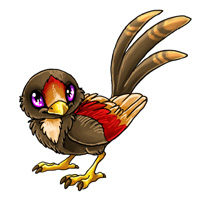Pet Facts



Skillow Facts
|
Skillow social structure is interesting because they think in terms of "we" rather than "I". When two or more Skillows are together, they think of themselves first and foremost as a group and only secondly (if at all) as an individual. They are a highly gregarious species and do very poorly alone, becoming anxious and stressed very quickly. If a Skillow is somehow isolated from its host or family for a prolonged period of time, it can actually die of loneliness if the situation becomes too much for it to bear. However, Skillows are also adaptable creatures and their concept of family is easily altered to encompass sudden changes to their lifestyle. If, for example, a Skillow is lost or orphaned, it will attempt to find for itself a new family. Oftentimes these "family members" aren't aware they've been adopted until they begin to notice gifts of berries, down and other little trinkets piled neatly near their homes or dens; a Skillow's way of showing goodwill and affection.
|
|
At sundown, great swaths of wild Skillows will amass in particular spots, coating every available branch and stem with a number of small feathery bodies so dense that the whole mass of them seems to blur the edges of the landscape. They twitter and fly in small groups; taking off from the branches in little clouds, whirling about then coming to land on top of their fellows just as another group takes off to do the same thing. They carry on like this for a while until suddenly the time is ripe and the whole host of Skillows takes to the sky. In these conditions they seem almost to cease being individual Skillows for the dense cloud of little bodies flying in tight formation takes on the appearance of a black sheet of fabric drifting in the sky. As the host flies in tandem - obeying some unknown pull - the curtain of Skillows undulates in a flow of mysterious patterns and shapes that capture the imagination. This phenomenon happens nearly every evening, save for particularly cold or stormy days, and is called by many names since Skillows are found all throughout the lands of Mistica. The most common term, however, is aleo, a native word for blackout.
|
|
The greater a host that gathers in preparation for aleo, the more a single Skillow forgets its individuality and integrates itself into the 'mindset' blackout as part of a whole. There are many mysteries surrounding the aleo, one of which is what happens to a Skillow's brain when it takes part in a blackout. When in the mindset of a blackout, a Skillow becomes actively connected with the Skillows directly around it. Like a network, when a Skillow participates in an aleo it becomes a part of a whole without which the whole could not function properly. Much like unaware cells form all thinking, self-aware bodies, this new body, made up of Skillows (who could be considered to be thinking, feeling, self-aware cells) form a new consciousness capable of things incomprehensible to us, such as our nature is incomprehensible to our cells. In aleo, Skillows are plugged into a collective consciousness - figuratively speaking, they become the cells, the nerves, the synapses for a vast entity beyond themselves.
|
|
Some ancient religions believed that Skillows would be a harbinger for the end of the world. They believed that when the time came, every living Skillow would be called to amass into the biggest aleo ever known and, connected at last, their network would encompass all of Mistica and together they would become the consciousness of a god. Because of this, some old religions revered Skillows as one of the most powerful creatures living in Mistica. This, however, is an incorrect way of thinking. While it is tempting to call this concept a 'god', the terminology is misleading. A better way to describe it would be to say that an aleo is the ultimate possibility, the unlocked potential of what it means to be a Skillow - connected with each other and the world around them.
|
|
The idea of a God, shattered into pieces, each bit lodged in a Skillow who has the ability to bring that god to life when it connects with every other Skillow, however, is a powerful one. Thus it is easy to see why Skillows have been entwined with the concept of fate since the birth of the ancient world. As the diviners and shamans of Mistica noticed, blackouts of Skillows often created seemingly deliberate patterns in the sky. They believed this was a form of seeing and many auspices would take place at the sites where hosts of Skillows congregated in preparation for their daily aleo. No one knows exactly why Skillows flock to these specific areas to participate in a blackout, and ancient people considered them holy places, though the actual reason is probably more practical.
|
|
Despite their godly status with ancient religions, Skillows are a fairly simple and common species. They live in large cone-shaped nests in family groups of twenty to fifty, and spend a great portion of their time bickering, eating, raising their young, and bickering some more. Well-known songbirds, Skillows are often welcomed in open-air markets. They're enticed there by offerings of seed and fruit, and their songs in turn draw curious shoppers to the heart of the market where customers can be most easily accosted by wares.
|
Go Back
